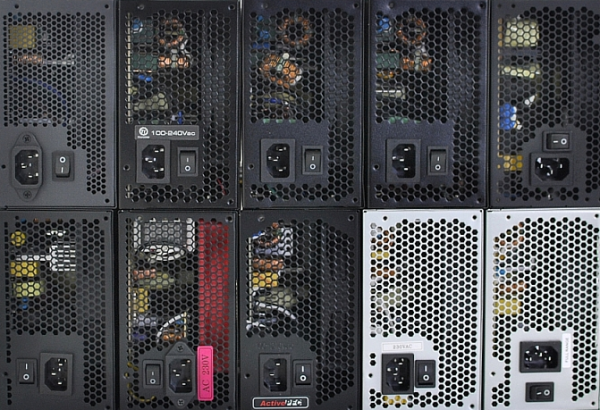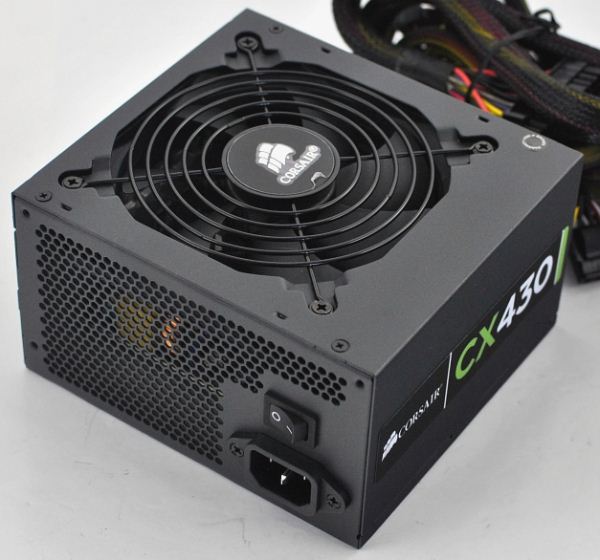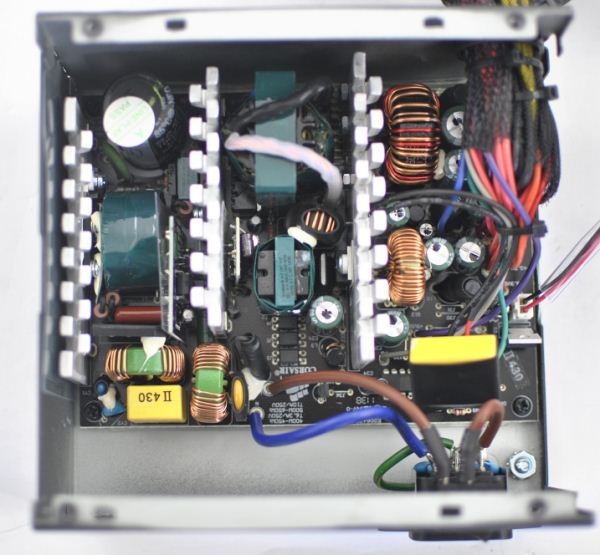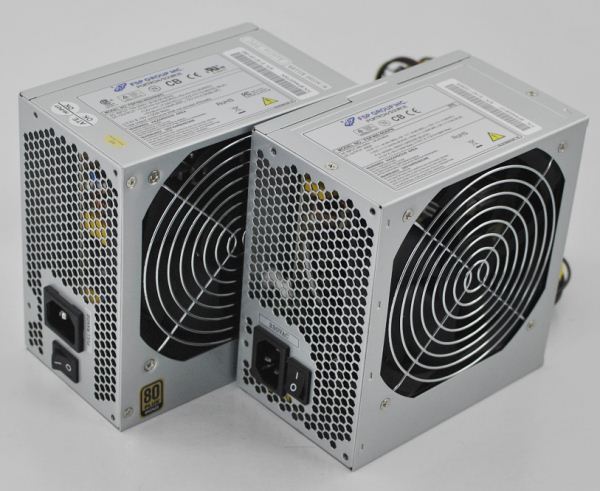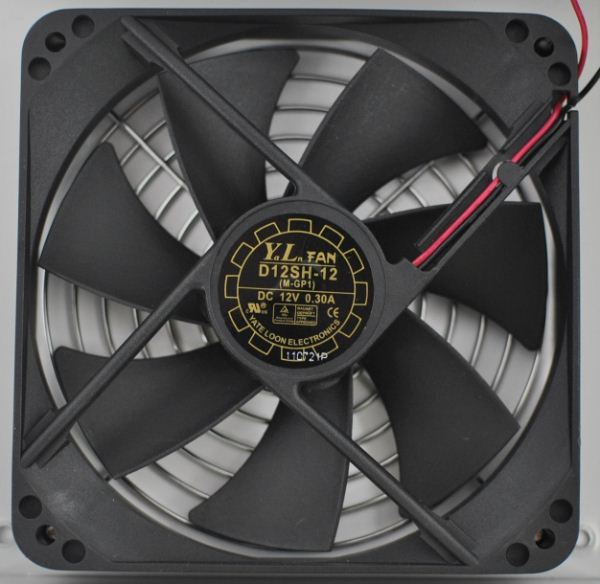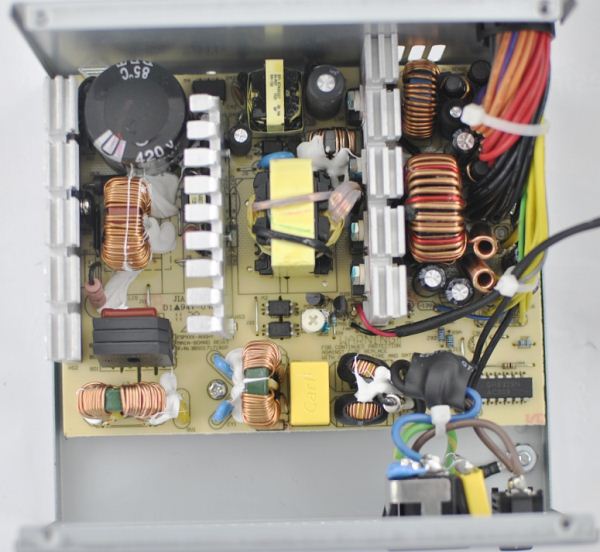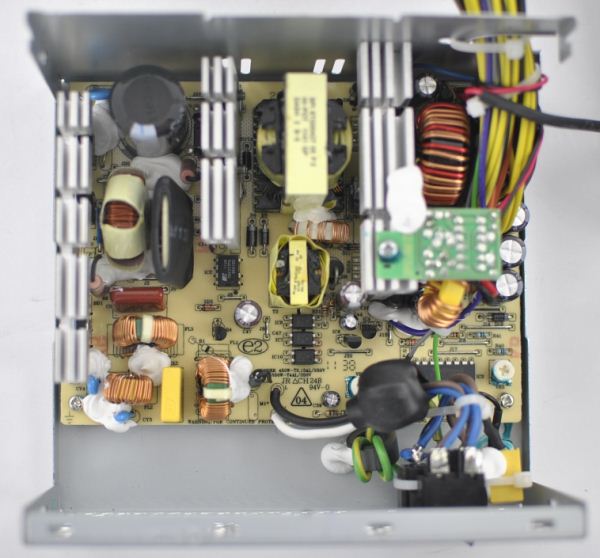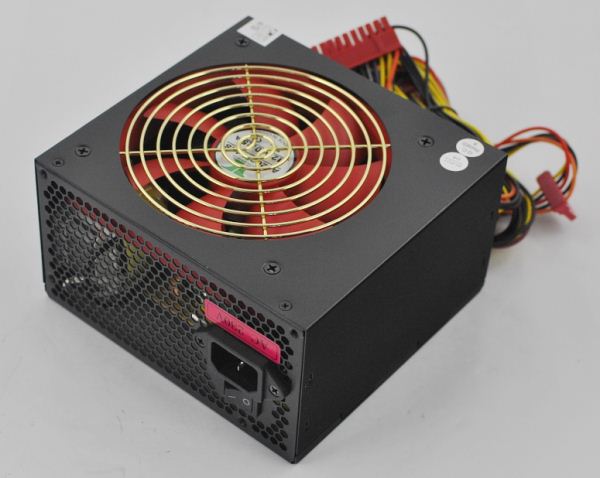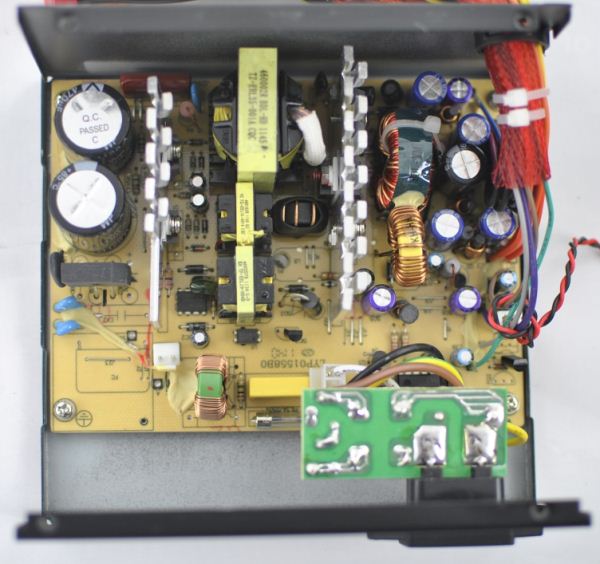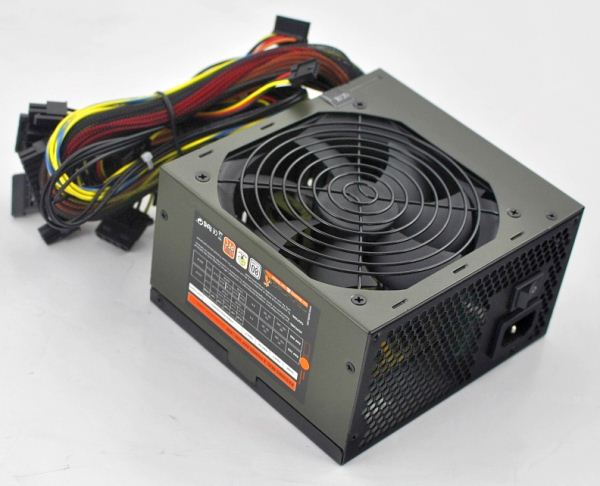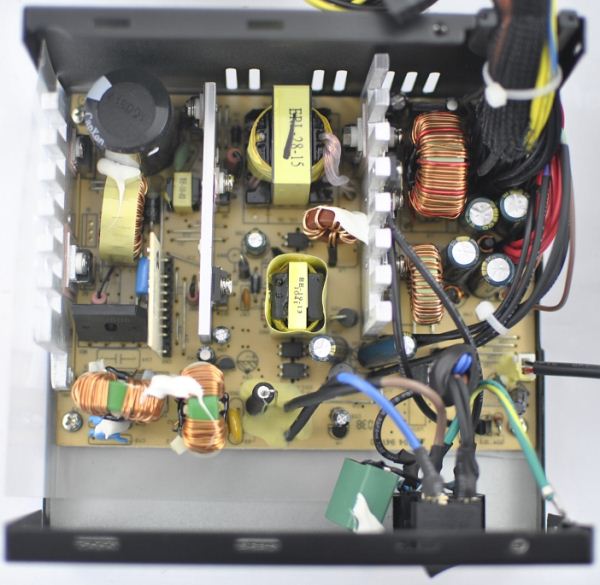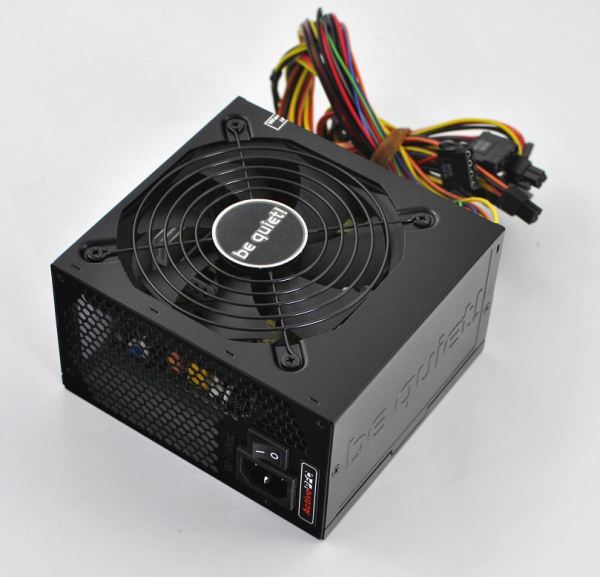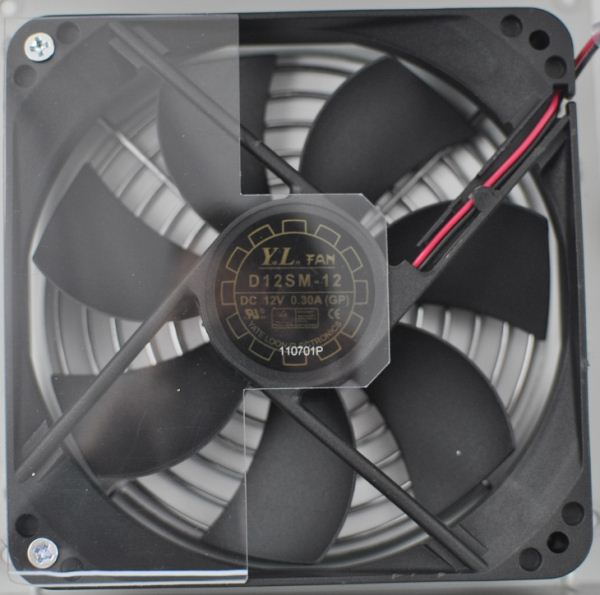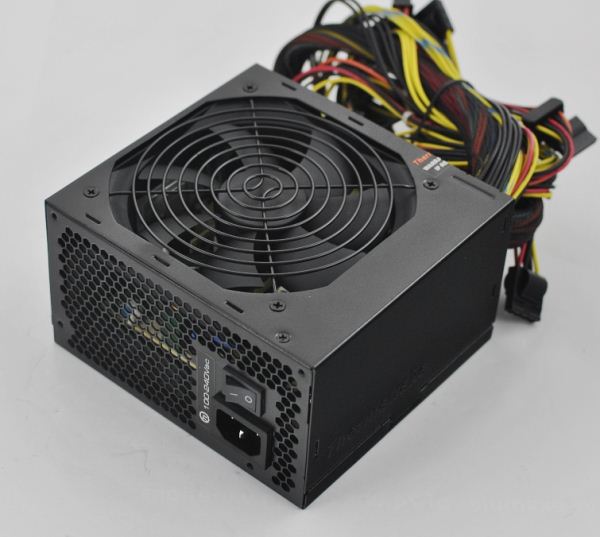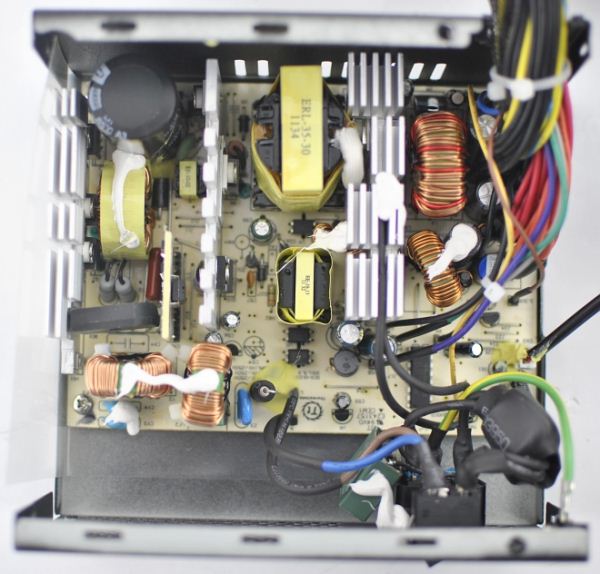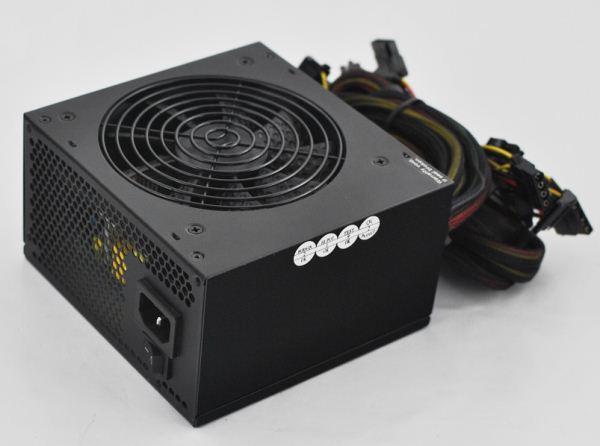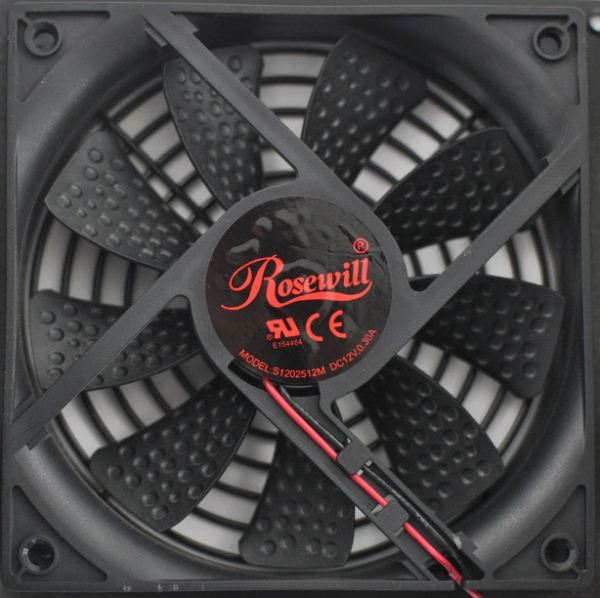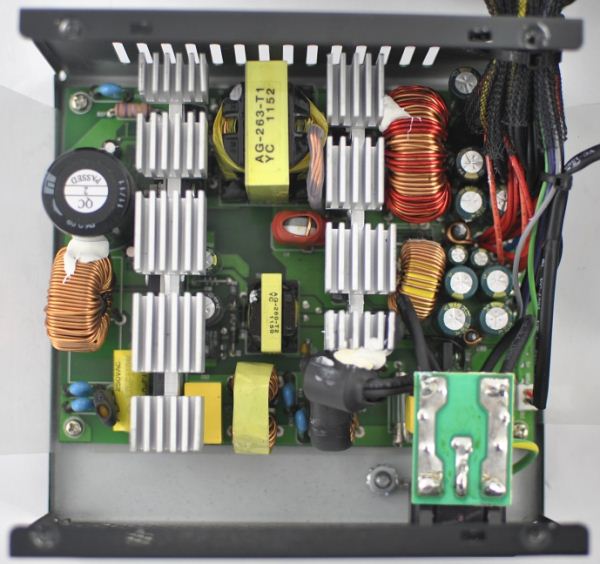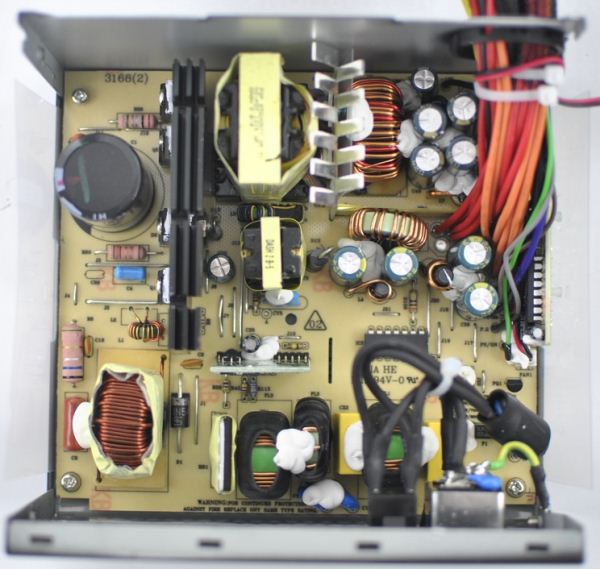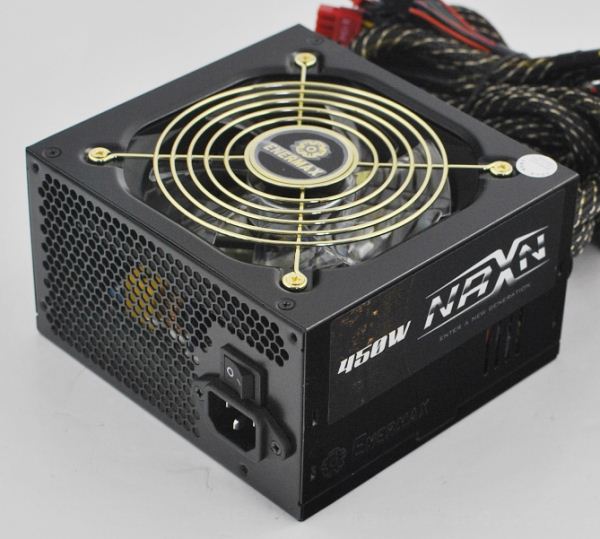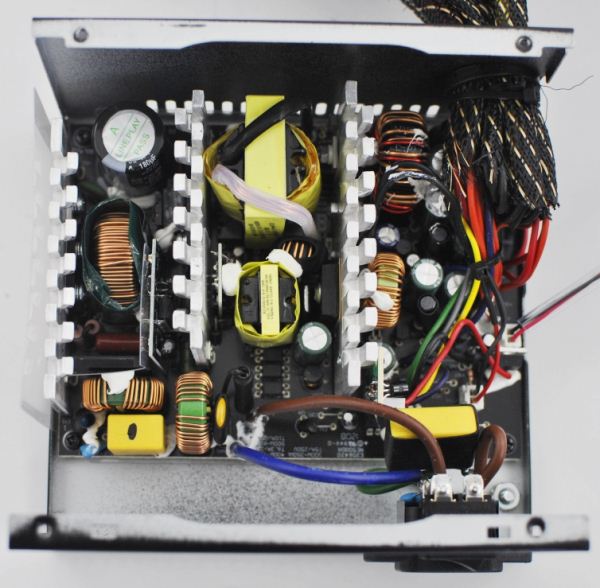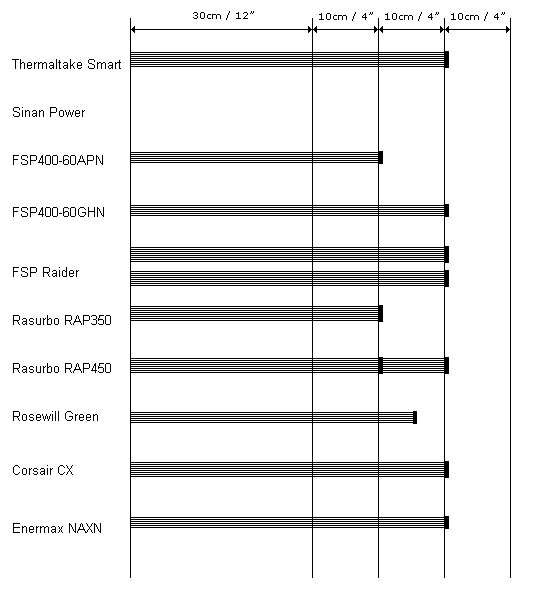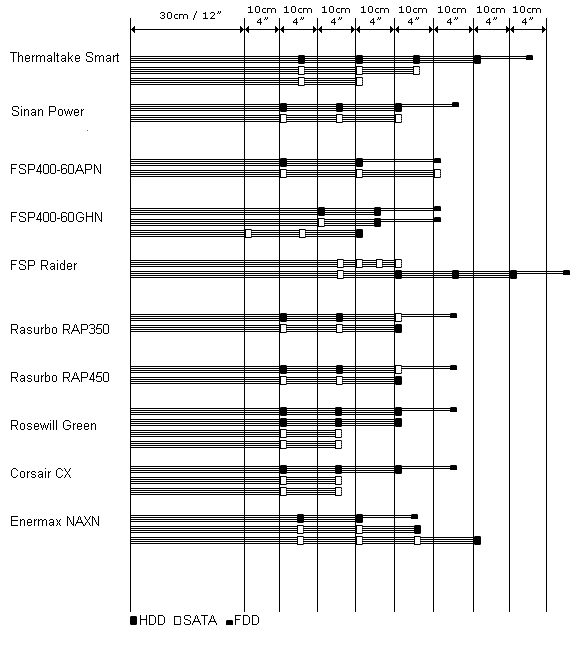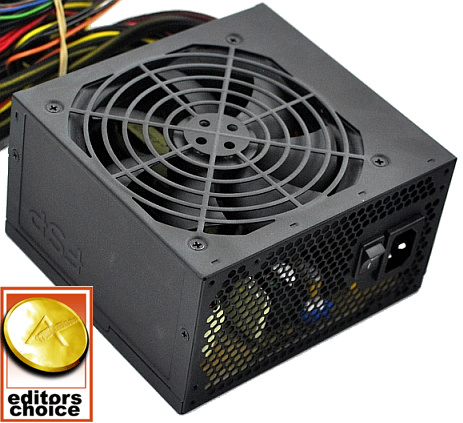
Original Link: https://www.anandtech.com/show/6013/350450w-roundup-11-cheap-psus
350-450W Roundup: 11 Cheap PSUs
by Martin Kaffei on July 3, 2012 1:30 PM EST350-450W Roundup: 11 Cheap PSUs
Some of you have suggested to review a few PSUs with 350W to 450W. Therefore we picked a collection of such units from well known and unknown manufacturers and tortured them with our overload tests. Read on to find out who delivers the best performance.
~400W is still plenty even for a midrange system, and with optimal efficiency generally coming at 50% load these power supplies should run closer to their "sweet spot" when idle as well as under load. There's still enough power on top to run a Core i7 or Phenom X6 processor and a discrete GPU.
Corsair CX430 V2 430W
Corsair was using Seasonic units for the majority of their products, but most of their cheaper offerings are now manufactured by CWT. The CX430 V2 is the lowest-end unit from Corsair, which still has enough quality to satisfy the customers. It comes in matt black and has a large Corsair logo on the fan grille. The back is perforated with hexagonal-shaped openings and a small power switch can be found above the power input.
The contents of the package are what you'd expect. You get the required four screws and power cord, naturally, along with some cable ties, a user manual with product data and safety references. Corsair prefers a large single-rail 12V design, rated at 28A (336W). The reason for the high rating of the 12V rail is the high power consumption of CPUs and GPUs.The small rails are rated at 20A each with a combined output of 120W; that's comparatively weak compared to some older PSUs, but since modern PCs usually don't need much from the low voltage rails, this will hardly be a problem.
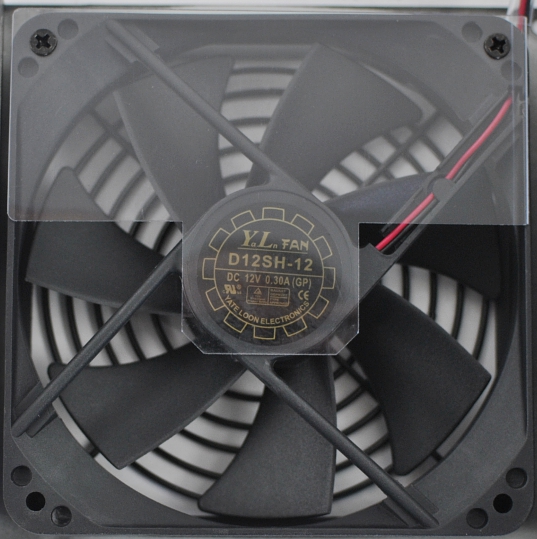
A 120mm Yate Loon fan cools these units. It has a ball bearing and seven sharp-edged fan blades. A plastic guard blocks part of the intake area to help direct airflow.
| Cables and Connectors | ||
|
Connector type (length) |
Main | 1x 24-pin (45cm) fixed |
| ATX12V/EPS12V | 1x 4+4-pin (50cm) fixed | |
| PCIe | 1x 6/8-pin (50cm) fixed | |
| Peripheral |
3x SATA (ca. 50, 65, 80cm) fixed 3x SATA (ca. 50, 65, 80cm) fixed |
|
| 3x HDD, 1x FDD (ca. 50, 65, 80, 95cm) fixed | ||
The inside reveals a typical CWT design with three heatsinks, two for the primary side and the third for the secondary side. Three of the filtering caps are attached to the other side of the AC jack. The internal layout is pretty typical using a two-transistor forward converter, with a minimal number of components in the transient filtering. The primary cap is made by Samxon--just like the secondary ones. They are a slightly lower end vendor CWT uses for these units.
Corsair CX430 V2 430W Measurements
Voltage Regulation
| +3.3V Regulation/Ripple and Noise | |
| Load | Voltage |
| 5% | 3.29 V (3mV) |
| 10% | 3.27 V (3mV) |
| 20% | 3.27 V (4mV) |
| 50% | 3.25 V (5mV) |
| 80% | 3.25 V (6mV) |
| 100% | 3.22 V (7mV) |
| 110% | 3.20 V (13mV) |
| Crossload +12V max. | -1.52% |
| Crossload +3.3V/+5V max. | -3.64% |
| +5V Regulation/Ripple and Noise | |
| Load | Voltage |
| 5% | 5.10 V (4mV) |
| 10% | 5.10 V (6mV) |
| 20% | 4.99 V (5mV) |
| 50% | 4.97 V (5mV) |
| 80% | 4.96 V (7mV) |
| 100% | 4.95 V (7mV) |
| 110% | 4.92 V (8mV) |
| Crossload +12V max. | -0.60% |
| Crossload +3.3V/+5V max. | -5.80% |
| +12V Regulation (Worst Ouput)/Ripple and Noise (Worst Output) | |
| Load | Voltage |
| 5% | 12.01 V (8mV) |
| 10% | 11.98 V (9mV) |
| 20% | 11.98 V (10mV) |
| 50% | 11.95 V (12mV) |
| 80% | 11.92 V (15mV) |
| 100% | 11.89 V (18mV) |
| 110% | 11.88 V (22mV) |
| Crossload +12V max. | -3.50% |
| Crossload +3.3V/+5V max. | -0.25% |
Noise Levels
| Sound Pressure Level (Ambient: 16dBA, 1m distance) and Temperatures (Δϑ to 23.4 °C ambient temperature) | |
| Load | Opinion |
| 5% | 17 dBA (1.0°C) |
| 10% | 17 dBA (1.9 °C) |
| 20% | 18 dBA (3.9 °C) |
| 50% | 22 dBA (6.4 °C) |
| 80% | 25 dBA (9.1 °C) |
| 100% | 27 dBA (10.5 °C) |
| 110% | 27 dBA (11.4 °C) |
Efficiency and PFC
| Efficiency and Power Factor 115 VAC | ||
| Load | Efficiency | PFC |
| 5% | 69.48% | 0.810 |
| 10% | 73.90% | 0.919 |
| 20% | 81.64% | 0.927 |
| 50% | 83.29% | 0.951 |
| 80% | 82.88% | 0.968 |
| 100% | 82.05% | 0.974 |
| 110% | 81.71% | 0.981 |
| Efficiency and Power Factor 230 VAC | ||
| Load | Efficiency | PFC |
| 5% | 69.97% | 0.795 |
| 10% | 75.12% | 0.890 |
| 20% | 82.15% | 0.902 |
| 50% | 84.90% | 0.931 |
| 80% | 83.79% | 0.961 |
| 100% | 82.90% | 0.971 |
| 110% | 82.43% | 0.975 |
The sound pressure level and found out, that this PSU has a good fan speed regulation. The RPMs are tolerable up to 50-80% load. Beyond that point, this PSU is no longer silent, but still quiet enough. Note the difference the power grid makes in terms of efficiency. 115VAC means higher current and more stress for all power supplies, while 230VAC shows a worse power factor at all loads. Nevertheless, 0.975 PFC is still good and most users will find 83% efficiency more than sufficient. All the rails fall clearly within ATX specifications.
FSP OEM 400W APN and GHN -1
FSP doesn't sell these OEM versions directly in the market. Instead, they find their way through various distributors and e-tailers to end-users. They come without any packaging because the companies want to keep this extra strictly to their retail version of the product. Therefore customers get a 2-year warranty. With 120W the 3.3V and 5V rails are rated somewhat lower than we're used to, but there's nothing to worry about since modern systems don't place a huge load on these rails anymore. The GHN model has no rating on 12V, the other one delivers 336W. FSP provides a low number of connectors for both products, but they are always able to customize the configuration e.g. by adding a 4+4-pin CPU connector for an OEM/ODM customer.
This Yate-Loon fan with the model number D12SH-12 and 120mm diameter uses sleeve bearings and seven fan blades. The maximum speed is 2200rpm at +12V. The subjective loudness of the fan (and the electronics of course) will be investigated on the following page.
| Cables and Connectors APN | ||
|
Connector type (length) |
Main | 1x 24-pin (50cm) fixed |
| ATX12V/EPS12V | 1x 4-pin (50cm) fixed | |
| PCIe | 1x 6-pin (40cm) fixed | |
| Peripheral | 3x SATA (ca. 40, 60, 80cm) fixed | |
| 2x HDD, 1x FDD (ca. 40, 60, 80cm) fixed | ||
| Cables and Connectors GHN | ||
|
Connector type (length) |
Main | 1x 24-pin (45cm) fixed |
| ATX12V/EPS12V | 1x 4-pin (50cm) fixed | |
| PCIe | 1x 6-pin (50cm) fixed | |
| Peripheral |
2x SATA, HDD (ca. 30, 45, 60cm) fixed 1x SATA, HDD, FDD (ca. 50, 65, 80cm) fixed |
|
| 2x HDD, 1x FDD (ca. 50, 65, 80, 95cm) fixed | ||
FSP400-60GHN(85)
FSP400-60APN (230V version)
The internal layout consists of three large heatsinks. Both main caps are made by CapXon and rated at 420V. It's also easy to spot the secondary capacitors and their respective manufacturers. FSP uses different suppliers for these PSUs, a few from Teapo and some from CapXon, both of which we have seen many times lately. Since the basic designs are several years old now, we didn't expect to find anything extraordinary within the design. However, both PSUs are still sold today and you can expect good quality from PSUs that use it.
FSP OEM 400W APN and GHN Measurements
Voltage Regulation
| +3.3V Regulation/Ripple and Noise APN/GHN | |
| Load | Voltage |
| 5% | 3.41V (7mV) / 3.38V (2mV) |
| 10% | 3.40V (9mV) / 3.38V (4mV) |
| 20% | 3.39V (14mV) / 3.36V (9mV) |
| 50% | 3.37V (19mV) / 3.34V (11mV) |
| 80% | 3.35V (24mV) / 3.32V (17mV) |
| 100% | 3.32V (28mV) / 3.32V (21mV) |
| 110% | 3.32V (30mV) / 3.31V (24mV) |
| Crossload +12V max. | +0.30% / -0.30% |
| Crossload +3.3V/+5V max. | -1.32% / -3.92 % |
| +5V Regulation/Ripple and Noise APN/GHN | |
| Load | Voltage |
| 5% | 5.10V (9mV) / 5.15V (13mV) |
| 10% | 5.10V (12mV) / 5.13V (15mV) |
| 20% | 4.99V (14mV) / 5.12V (19mV) |
| 50% | 4.97V (18mV) / 5.08V (23mV) |
| 80% | 4.96V (22mV) / 5.04V (28mV) |
| 100% | 4.95V (26mV) / 5.04V (34mV) |
| 110% | 4.92V (25mV) / 5.02V (37mV) |
| Crossload +12V max. | -0.40% / -2.60% |
| Crossload +3.3V/+5V max. | -3.00% / -4.60% |
| +12V Regulation (Worst Ouput)/Ripple and Noise (Worst Output) APN/GHN | |
| Load | Voltage |
| 5% | 12.01V (2mV) / 12.09V (7mV) |
| 10% | 11.98V (5mV) / 12.09V (12mV) |
| 20% | 11.98V (13mV) / 12.09V (21mV) |
| 50% | 11.95V (20mV) / 12.07V (29mV) |
| 80% | 11.92V (25mV) / 12.05V (36mV) |
| 100% | 11.89V (32mV) / 12.05V (42mV) |
| 110% | 11.88V (41mV) / 12.03V (58mV) |
| Crossload +12V max. | -3.16% / -2,75% |
| Crossload +3.3V/+5V max. | +3.75% / -2.42% |
Noise Levels
| Sound Pressure Level (Ambient: 16dBA, 1m distance) and Temperatures (Δϑ to 25.7 °C ambient temperature) APN/GHN | |
| Load | Opinion |
| 5% | 20 dBA (3.7°C) / 18 dBA (1.5°C) |
| 10% | 20 dBA (4.4 °C) / 18 dBA (2.1°C) |
| 20% | 20 dBA (5.8 °C) / 19 dBA (4.7°C) |
| 50% | 23 dBA (7.7 °C) / 19 dBA (5.6°C) |
| 80% | 25 dBA (11.1 °C) / 22 dBA (8.7°C) |
| 100% | 28 dBA (11.5 °C) / 24 dBA (10.0°C) |
| 110% | 29 dBA (12.3 °C) / 27 dBA (10.5°C) |
Efficiency and PFC
| Efficiency and Power Factor 115 VAC GHN | ||
| Load | Efficiency | PFC |
| 5% | 70.03% | 0.882 |
| 10% | 76.56% | 0.921 |
| 20% | 83.71% | 0.956 |
| 50% | 85.92% | 0.968 |
| 80% | 85.15% | 0.976 |
| 100% | 84.39% | 0.982 |
| 110% | 83.97% | 0.987 |
| Efficiency and Power Factor 230 VAC APN/GHN | ||
| Load | Efficiency | PFC |
| 5% | 69.62% / 71.12% | 0.810 / 0.852 |
| 10% | 77.37% / 79.10% | 0.911 / 0.899 |
| 20% | 82.93% / 84.34% | 0.937 / 0.913 |
| 50% | 84.64% / 86.76% | 0.971 / 0.945 |
| 80% | 83.71% / 86.65% | 0.984 / 0.967 |
| 100% | 83.27% / 85.75% | 0.988 / 0.977 |
| 110% | 82.77% / 84.39% | 0.990 / 0.980 |
The voltage stability of both PSUs is close to most retail units. The 3.3V rail had the highest voltage. The 5V rails stayed above 4.92V throughout our load testing. All 12V rails stayed well within specs as well. All of the different voltages delivered low ripple and noise results, staying well within specs. Only crossload performance could be much better. The GHN is certified as an 80Plus Bronze power supply, and our efficiency results confirmed that rating.
Sinan Power VP-430 430W
Sinan Power is a brand most of our readers likely have not encountered. The company behind (Inter-Tech) is in Germany, where their largest customer base is located. Inter-Tech would've never thought about sending us a unit like the VP-430, which is why we got this sample from Amazon. It comes with passive PFC (no universal AC input) and a red fan. The package includes a power cord for the European power grid, four screws, some cable ties, and a manual.
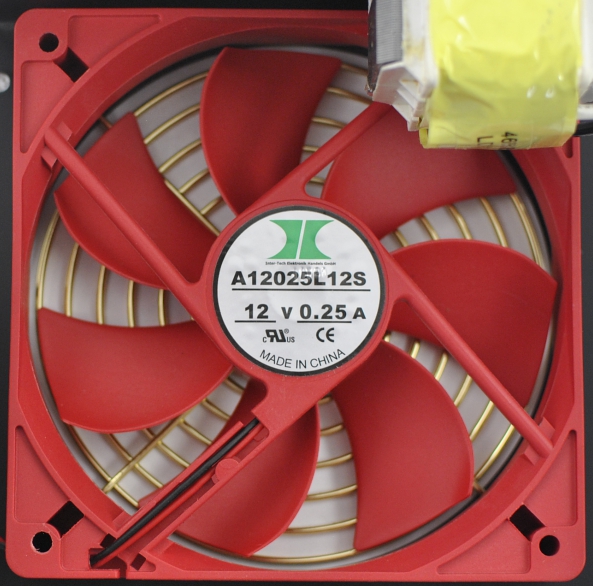
We assume Yate Loon makes the fan, one of the largest companies. The 120mm fan needs fewer amps than the other fans in this roundup and it has seven cheap fan blades. Definitely a low-quality product.
| Cables and Connectors | ||
|
Connector type (length) |
Main | 1x 24-pin (40cm) fixed |
| ATX12V/EPS12V | 1x 4+4-pin (40cm) fixed | |
| PCIe | - | |
| Peripheral | 3x SATA (ca. 40, 55, 70cm) fixed | |
| 3x HDD, 1x FDD (ca. 40, 55, 70, 85cm) fixed | ||
The internals consist of thin heatsinks, a small transformer, and a big and noisy PFC-choke under the fan. The undersized bridge rectifier has no heatsink. There are a few components in the EMI filtering stage, but all the other parts are low-end. It doesn't look like 430W. Inter-Tech (we couldn't detect the real manufacturer) implemented a forward converter with the cheapest output caps and magnetic cores available.
Sinan Power VP-430 430W Measurements
Voltage Regulation
| +3.3V Regulation/Ripple and Noise | |
| Load | Voltage |
| 5% | 3.37V (8mV) |
| 10% | 3.37V (14mV) |
| 20% | 3.36V (24mV) |
| 50% | 3.35V (45mV) |
| 80% | FAIL |
| 100% | FAIL |
| 110% | FAIL |
| Crossload +12V max. | FAIL |
| Crossload +3.3V/+5V max. | FAIL |
| +5V Regulation/Ripple and Noise | |
| Load | Voltage |
| 5% | 5.11V (2mV) |
| 10% | 5.09V (15mV) |
| 20% | 5.08V (18mV) |
| 50% | 5.04V (29mV) |
| 80% | FAIL |
| 100% | FAIL |
| 110% | FAIL |
| Crossload +12V max. | FAIL |
| Crossload +3.3V/+5V max. | FAIL |
| +12V Regulation (Worst Ouput)/Ripple and Noise (Worst Output) | |
| Load | Voltage |
| 5% | 11.97V (6mV) |
| 10% | 11.95V (20mV) |
| 20% | 11.93V (38mV) |
| 50% | 11.87V (56mV) |
| 80% | FAIL |
| 100% | FAIL |
| 110% | FAIL |
| Crossload +12V max. | FAIL |
| Crossload +3.3V/+5V max. | FAIL |
Noise Levels
| Sound Pressure Level (Ambient: 16dBA, 1m distance) and Temperatures (Δϑ to 24.9 °C ambient temperature) | |
| Load | Opinion |
| 5% | 19 dBA (1.4°C) |
| 10% | 19 dBA (3.4 °C) |
| 20% | 24 dBA (8.5 °C) |
| 50% | 28 dBA (11.3 °C) |
| 80% | FAIL |
| 100% | FAIL |
| 110% | FAIL |
Efficiency and PFC
| Efficiency and Power Factor 115 VAC | ||
| Load | Efficiency | PFC |
| 5% | - | - |
| 10% | - | - |
| 20% | - | - |
| 50% | - | - |
| 80% | - | - |
| 100% | - | - |
| 110% | - | - |
| Efficiency and Power Factor 230 VAC | ||
| Load | Efficiency | PFC |
| 5% | 56.00% | 0.655 |
| 10% | 66.98% | 0.712 |
| 20% | 73.40% | 0.730 |
| 50% | 74.13% | 0.725 |
| 80% | FAIL | FAIL |
| 100% | FAIL | FAIL |
| 110% | FAIL | FAIL |
As you can see, the PSU turned off after 50% load. All the rails are still within specification at 50%, but efficiency is low staying below 75% all the time. +12V stays stable with more than 11.87V at all tested loads, but naturally the failure at 80% load is a major black mark. PFC is as low as expected and still acceptable for a passive-PFC unit. We've seen such results quite often.
Rasurbo RAP 350 & 450W
Rasurbo is a German brand and HEC is the OEM behind many products including the Real&Power series. HEC (or COMPUCASE) has been making power supplies and other products for quite a while now. Cougar is their well known retail brand. Today we will review the 350 and 450W version HEC built for Rasurbo. Features include 80Plus and silent operation. Both PSUs come in a dark green/black housing with just 14 cm depth. Two 12V rails provide more than enough combined power for most graphics cards. The devices get cooled by 120mm fans and various extras such as cable ties are within the scope of supply.

Rasurbo uses a fan from Young Lin with the model number DFS122512M. M stands for "medium rotations per minute" (2000RPM). This common sleeve ball bearing type fan has a peak power consumption of 2.8W and has seven fan blades.
| Cables and Connectors RAP350/RAP450 | ||
|
Connector type (length) |
Main | 1x 24-pin (45cm) fixed |
| ATX12V/EPS12V | 1x 4+4-pin (60cm) fixed | |
| PCIe | 1x 6/8-pin (40cm) fixed, 450W: 2x 6/8-pin (45, 60cm) fixed | |
| Peripheral | 2x SATA, 1x HDD (ca. 40, 55, 70cm) fixed | |
| 2x HDD, 1x SATA, 1x FDD (ca. 40, 55, 70, 85cm) fixed | ||
Looking inside of this unit shows a similar heatsink design to what we saw in the FSP units. This time they look less massive. Most of the capacitors are made by Teapo; the primary one comes from Capxon. EMI filtering consists of two common mode chokes, four Y-caps, and two X-caps. An IC on the secondary side features safety functions such as OCP and short circuit protection. There is a lot of glue inside but it's better to fix heavy components rather than reducing safety for better looking electronics. The main transformer is somewhat small but we should mention that this is the 350W version. The larger one has a similar design with different components.
Rasurbo RAP 350W Measurements
Voltage Regulation
| +3.3V Regulation/Ripple and Noise | |
| Load | Voltage |
| 5% | 3.30V (7mV) |
| 10% | 3.29V (11mV) |
| 20% | 3.28V (14mV) |
| 50% | 3.24V (20mV) |
| 80% | 3.24V (24mV) |
| 100% | 3.21V (28mV) |
| 110% | 3.19V (37mV) |
| Crossload +12V max. | -0.91% |
| Crossload +3.3V/+5V max. | -3.94% |
| +5V Regulation/Ripple and Noise | |
| Load | Voltage |
| 5% | 5.13V (5mV) |
| 10% | 5.12V (10mV) |
| 20% | 5.00V (18mV) |
| 50% | 4.98V (23mV) |
| 80% | 4.97V (31mV) |
| 100% | 4.92V (34mV) |
| 110% | 4.87V (39mV) |
| Crossload +12V max. | +3.00% |
| Crossload +3.3V/+5V max. | -3.00% |
| +12V Regulation (Worst Ouput)/Ripple and Noise (Worst Output) | |
| Load | Voltage |
| 5% | 12.14V (9mV) |
| 10% | 12.08V (15mV) |
| 20% | 12.05V (19mV) |
| 50% | 11.99V (21mV) |
| 80% | 11.95V (35mV) |
| 100% | 11.87V (42mV) |
| 110% | 11.80 V (48mV) |
| Crossload +12V max. | +3.00% |
| Crossload +3.3V/+5V max. | -3.25% |
Noise Levels
| Sound Pressure Level (Ambient: 16dBA, 1m distance) and Temperatures (Δϑ to 24.2 °C ambient temperature) | |
| Load | Opinion |
| 5% | 17 dBA (0.9°C) |
| 10% | 17 dBA (1.5 °C) |
| 20% | 17 dBA (2.9 °C) |
| 50% | 20 dBA (7.1 °C) |
| 80% | 24 dBA (9.5 °C) |
| 100% | 26 dBA (10.4 °C) |
| 110% | 26 dBA (10.9 °C) |
Efficiency and PFC
| Efficiency and Power Factor 115 VAC | ||
| Load | Efficiency | PFC |
| 5% | 69.97% | 0.790 |
| 10% | 76.27% | 0.840 |
| 20% | 83.10% | 0.937 |
| 50% | 85.49% | 0.962 |
| 80% | 83.98% | 0.973 |
| 100% | 83.56% | 0.980 |
| 110% | 83.32% | 0.987 |
| Efficiency and Power Factor 230 VAC | ||
| Load | Efficiency | PFC |
| 5% | 70.70% | 0.738 |
| 10% | 77.42% | 0.814 |
| 20% | 83.90% | 0.923 |
| 50% | 86.27% | 0.945 |
| 80% | 85.20% | 0.969 |
| 100% | 84.87% | 0.978 |
| 110% | 84.23% | 0.985 |
We focus on the 350W model this time as it is more interesting for most readers. We see very little voltage drop on the rails, which is very good. Ripple on the 12V rails is also exceptionally good, measuring at most 48mV. Lower voltage rails also perform decently, measuring up to 39mV. The results meet the 80Plus Bronze requirements, actually reaching a maximum of 86% efficiency, but it's important to note that this is only possible on 230VAC. All PSUs in this roundup have a poor regulation during crossload including the RAP model.
be quiet! System Power 350W
be quiet!, a German brand from Listan, showed some interesting new products at Computex. Beside their famous E9 and P10 retail series Listan offers some power supplies for system houses as well. Today we take a look at one of those products at 350W. There are a no extras in the package except a power cord, which is typical for such products. 300W combined power on 12V indicates this is a modern PSU. +3.3V and +5V are rated at 23A each and should be able to provide enough power for HDDs/SSDs and/or other peripheral components.
This common Yate-Loon fan with the model number D12SM-12 and 120mm diameter uses sleeve bearings and seven fan blades. The maximum speed is 1650rpm at +12V. The subjective loudness of the fan (and the electronics of course) will be investigated on the following page. be quiet! uses FDB fans for almost every PSU they offer so this choice is somewhat disappointing.
| Cables and Connectors | ||
|
Connector type (length) |
Main | 1x 24-pin (40cm) fixed |
| ATX12V/EPS12V | 1x 4+4-pin (40cm) fixed | |
| PCIe | - | |
| Peripheral | 2x SATA, 1x HDD (ca. 40, 60, 75cm) fixed | |
| 1x SATA, 2x HDD, 1x FDD (ca. 30, 40, 60, 75cm) fixed | ||
This PSU reminds us of one of the OEM solution FSP delivered. It's another three-heatsink design with a common forward conveter and small components. EMI filtering consists of all necessary components except a MOV. The bridge rectifier got a small heatsink and all caps are manufactured by Capxon. At the far right the fan speed regulator can be found on a separate PCB.
be quiet! System Power 350W Measurements
Voltage Regulation
| +3.3V Regulation/Ripple and Noise | |
| Load | Voltage |
| 5% | 3.41V (9mV) |
| 10% | 3.37V (12mV) |
| 20% | 3.36V (14mV) |
| 50% | 3.34V (22mV) |
| 80% | 3.33V (31mV) |
| 100% | 3.31V (35mV) |
| 110% | 3.30V (41mV) |
| Crossload +12V max. | +1.52% |
| Crossload +3.3V/+5V max. | +0.00% |
| +5V Regulation/Ripple and Noise | |
| Load | Voltage |
| 5% | 5.04V (7mV) |
| 10% | 5.03V (13mV) |
| 20% | 5.00V (15mV) |
| 50% | 4.98V (25mV) |
| 80% | 4.97V (33mV) |
| 100% | 4.94V (39mV) |
| 110% | 4.91V (42mV) |
| Crossload +12V max. | +2.00% |
| Crossload +3.3V/+5V max. | -6.20% |
| +12V Regulation (Worst Ouput)/Ripple and Noise (Worst Output) | |
| Load | Voltage |
| 5% | 12.14V (11mV) |
| 10% | 12.08V (15mV) |
| 20% | 12.05V (19mV) |
| 50% | 11.99V (31mV) |
| 80% | 11.95V (51mV) |
| 100% | 11.87V (59mV) |
| 110% | 11.86 V (61mV) |
| Crossload +12V max. | -2.92% |
| Crossload +3.3V/+5V max. | +8.67% |
Noise Levels
| Sound Pressure Level (Ambient: 16dBA, 1m distance) and Temperatures (Δϑ to 24.2 °C ambient temperature) | |
| Load | Opinion |
| 5% | 18 dBA (0.5°C) |
| 10% | 19 dBA (1.6 °C) |
| 20% | 19 dBA (2.5 °C) |
| 50% | 19 dBA (3.4 °C) |
| 80% | 22 dBA (5.2 °C) |
| 100% | 24 dBA (6.4 °C) |
| 110% | 24 dBA (8.5 °C) |
Efficiency and PFC
| Efficiency and Power Factor 115 VAC | ||
| Load | Efficiency | PFC |
| 5% | 68.34% | 0.872 |
| 10% | 76.16% | 0.902 |
| 20% | 82.67% | 0.926 |
| 50% | 84.92% | 0.938 |
| 80% | 84.49% | 0.942 |
| 100% | 83.78% | 0.949 |
| 110% | 83.33% | 0.957 |
| Efficiency and Power Factor 230 VAC | ||
| Load | Efficiency | PFC |
| 5% | 69.49% | 0.866 |
| 10% | 77.75% | 0.880 |
| 20% | 83.21% | 0.917 |
| 50% | 85.86% | 0.925 |
| 80% | 85.58% | 0.934 |
| 100% | 84.52% | 0.938 |
| 110% | 83.73% | 0.940 |
be quiet! is clearly out of ATX specification during the second crossload test while noise and temperatures are low. The 3.3V and 5V rails start slightly above specification during 10% load; they then drop, reaching 3.30V and 4.91V at maximum load. The 12V rails start high at 12.14V and drops to 11.86V with 10% overload. These voltage drops will not cause any problem at all when this PSU is in use in a system.
Thermaltake Smart SP-430P 430W
Thermaltake is one of many companies with PSUs made by HEC. Inside the box are power supply, a small manual, screws, and a power cable. The 3.3V and 5V rails in the 430W unit are rated at 15A and 24A. The model has 34A on 12V which is quite much for a PSU without DC-to-DC. Features of the product include the 80Plus certificate and a 3 year warranty.
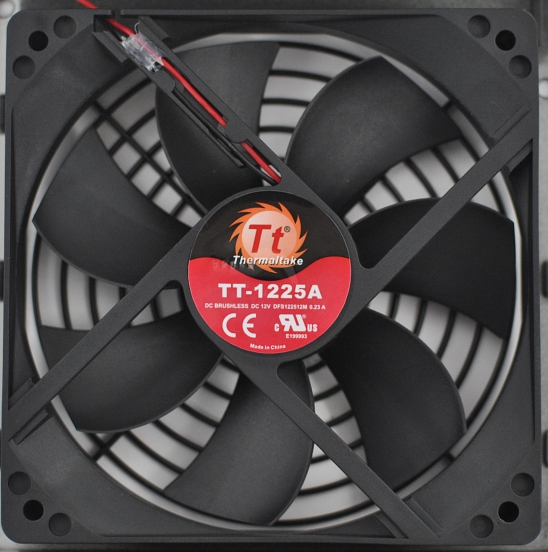
Thermaltake relies on its "own" fan for cooling, with the model number TT-1225A. This one has seven fan blades and is based on a common sleeve bearing. We didn't find any information about the RPM rating but we assume Young Lin built this fan as they are a large vendor and HEC uses them steadily.
| Cables and Connectors | ||
|
Connector type (length) |
Main | 1x 24-pin (55cm) fixed |
| ATX12V/EPS12V | 1x 4+4-pin (55cm) fixed | |
| PCIe | 1x 6/8-pin (50cm) fixed | |
| Peripheral |
3x SATA (ca. 40, 55, 70cm) fixed 2x SATA (ca. 40, 65cm) fixed |
|
| 4x HDD, 1x FDD (ca. 45, 60, 75, 90, 105cm) fixed | ||
There are three heatsinks and and typical components for a HEC power supply. The mainboard consists of epoxy resin and laminated paper. The same is ture for the small PCB with the PWM/PFC control. All capacitors are made by Teapo so the main cap is not a Japanse one. For +3.3V and +5V regulation this PSU uses a kind of "magamp" regulator like most PSUs do. The EMI filtering includes all the important components.
Thermaltake Smart SP-430P 430W Measurements
Voltage Regulation
| +3.3V Regulation/Ripple and Noise | |
| Load | Voltage |
| 5% | 3.29V (4mV) |
| 10% | 3.29V (10mV) |
| 20% | 3.28V (18mV) |
| 50% | 3.27V (24mV) |
| 80% | 3.25V (36mV) |
| 100% | 3.24V (38mV) |
| 110% | 3.24V (43mV) |
| Crossload +12V max. | +0.61% |
| Crossload +3.3V/+5V max. | +0.30% |
| +5V Regulation/Ripple and Noise | |
| Load | Voltage |
| 5% | 4.98V (8mV) |
| 10% | 4.98V (11mV) |
| 20% | 4.97V (17mV) |
| 50% | 4.94V (30mV) |
| 80% | 4.91V (34mV) |
| 100% | 4.88V (40mV) |
| 110% | 4.88V (45mV) |
| Crossload +12V max. | +1.00% |
| Crossload +3.3V/+5V max. | -2.60% |
| +12V Regulation (Worst Ouput)/Ripple and Noise (Worst Output) | |
| Load | Voltage |
| 5% | 12.14V (9mV) |
| 10% | 12.08V (11mV) |
| 20% | 12.05V (20mV) |
| 50% | 11.99V (25mV) |
| 80% | 11.95V (29mV) |
| 100% | 11.87V (35mV) |
| 110% | 11.86 V (45mV) |
| Crossload +12V max. | -4.25% |
| Crossload +3.3V/+5V max. | +3.25% |
Noise Levels
| Sound Pressure Level (Ambient: 16dBA, 1m distance) and Temperatures (Δϑ to 24.5 °C ambient temperature) | |
| Load | Opinion |
| 5% | 17 dBA (0.8°C) |
| 10% | 18 dBA (2.6 °C) |
| 20% | 20 dBA (4.9 °C) |
| 50% | 22 dBA (6.7°C) |
| 80% | 26 dBA (8.5 °C) |
| 100% | 26 dBA (9.1 °C) |
| 110% | 26 dBA (10.7 °C) |
Efficiency and PFC
| Efficiency and Power Factor 115 VAC | ||
| Load | Efficiency | PFC |
| 5% | 61.92% | 0.872 |
| 10% | 72.88% | 0.902 |
| 20% | 79.81% | 0.926 |
| 50% | 82.34% | 0.938 |
| 80% | 81.91% | 0.942 |
| 100% | 81.52% | 0.949 |
| 110% | 81.19% | 0.957 |
| Efficiency and Power Factor 230 VAC | ||
| Load | Efficiency | PFC |
| 5% | 63.31% | 0.790 |
| 10% | 74.09% | 0.835 |
| 20% | 80.87% | 0.896 |
| 50% | 83.64% | 0.937 |
| 80% | 83.19% | 0.967 |
| 100% | 82.84% | 0.973 |
| 110% | 82.23% | 0.975 |
Efficiency is one of the lowest we've seen in this review; even worse than what Rasurbo is able to provide. Both have the same 80Plus certification and HEC ist the manufacturer. During 20% load Thermaltake didn't even surpass the minimum requirement. As if this wasn't enough ripple was very high on the smaller outputs.
Rosewill Green Series RG430-S12 430W
Most enthusiasts are familiar with Rosewill as an US brand of inexpensive products of decent quality. They've had power supplies on the market for ages, but those products are almost always for budget builds. This time Rosewill sent a PSU which is more "expensive". The Green Series is efficient (80Plus) and comes with several extras such as cable ties. The 430W unit can theoretically draw up to 10A from the power grid (115VAC), and it delivers up to 33A on the single +12V rail. The maximum output from 12V is thus 396W if you don't stress the other rails, which are both rated at 24A. Together, 3.3V and 5V can deliver an additional 140W, which is more than enough for a system with modern components such as SSDs.
At first we couldn't identify the manufacturer of this fan as Rosewill is the only name we saw on the label. However, the model number S1202512M told us that GlobeFan is the company behind. This sleeve bearing type has a maximum rotational speed of 2400RPM.
| Cables and Connectors | ||
|
Connector type (length) |
Main | 1x 24-pin (55cm) fixed |
| ATX12V/EPS12V | 1x 4+4-pin (50cm) fixed | |
| PCIe | 1x 6-pin (45cm) fixed | |
| Peripheral |
2x SATA (ca. 40, 55cm) fixed 2x SATA (ca. 40, 55cm) fixed |
|
|
3x HDD (ca. 40, 55, 70cm) fixed 3x HDD, 1x FDD (ca. 40, 55, 70, 85cm) fixed |
||
Here we have a typical ATNG design with two large heatsinks. The EMI filtering is equipped well and it's nice to see that there are Taiwanese capacitors. The Teapo models don't have the longest lifetime and lowest ESR; however, we've never detected a problem with Teapo in power supplies.
Rosewill Green Series RG430-S12 430W Measurements
Voltage Regulation
| +3.3V Regulation/Ripple and Noise | |
| Load | Voltage |
| 5% | 3.29V (4mV) |
| 10% | 3.29V (10mV) |
| 20% | 3.28V (18mV) |
| 50% | 3.27V (24mV) |
| 80% | 3.25V (36mV) |
| 100% | 3.24V (38mV) |
| 110% | 3.24V (43mV) |
| Crossload +12V max. | +0.61% |
| Crossload +3.3V/+5V max. | +0.30% |
| +5V Regulation/Ripple and Noise | |
| Load | Voltage |
| 5% | 4.98V (8mV) |
| 10% | 4.98V (11mV) |
| 20% | 4.97V (17mV) |
| 50% | 4.94V (30mV) |
| 80% | 4.91V (34mV) |
| 100% | 4.88V (40mV) |
| 110% | 4.88V (45mV) |
| Crossload +12V max. | +1.00% |
| Crossload +3.3V/+5V max. | -2.60% |
| +12V Regulation (Worst Ouput)/Ripple and Noise (Worst Output) | |
| Load | Voltage |
| 5% | 12.14V (9mV) |
| 10% | 12.08V (11mV) |
| 20% | 12.05V (20mV) |
| 50% | 11.99V (25mV) |
| 80% | 11.95V (29mV) |
| 100% | 11.87V (35mV) |
| 110% | 11.86 V (37mV) |
| Crossload +12V max. | -4.25% |
| Crossload +3.3V/+5V max. | +3.25% |
Noise Levels
| Sound Pressure Level (Ambient: 16dBA, 1m distance) and Temperatures (Δϑ to 24.5 °C ambient temperature) | |
| Load | Opinion |
| 5% | 17 dBA (0.8°C) |
| 10% | 18 dBA (2.6 °C) |
| 20% | 20 dBA (4.9 °C) |
| 50% | 22 dBA (6.7°C) |
| 80% | 26 dBA (8.5 °C) |
| 100% | 26 dBA (9.1 °C) |
| 110% | 26 dBA (10.7 °C) |
Efficiency and PFC
| Efficiency and Power Factor 115 VAC | ||
| Load | Efficiency | PFC |
| 5% | 61.92% | 0.872 |
| 10% | 72.88% | 0.902 |
| 20% | 79.81% | 0.926 |
| 50% | 82.34% | 0.938 |
| 80% | 81.91% | 0.942 |
| 100% | 81.52% | 0.949 |
| 110% | 81.19% | 0.957 |
| Efficiency and Power Factor 230 VAC | ||
| Load | Efficiency | PFC |
| 5% | 63.31% | 0.790 |
| 10% | 74.09% | 0.835 |
| 20% | 80.87% | 0.896 |
| 50% | 83.73% | 0.937 |
| 80% | 83.19% | 0.967 |
| 100% | 82.84% | 0.973 |
| 110% | 82.23% | 0.975 |
Like most current PSUs the Rosewill Green has a low voltage drop on all rails, even at overload. 12V stays under 40mV ripple while +3.3V and +5V reach more than 40mV. The Rosewill Green is nearly not audible at low load; at 50% load we can definitely hear the fan, but 22 dB(A) is far from a bad result. The efficiency isn't great at 10% load, but 80Plus certification only tests at 20, 50 and 100% load so all the results fall in the expected 80Plus range.
FSP Raider 450W 80Plus Bronze
FSP sent a pre-production sample with the name "Raider", a new series for retail market. There's no package or delivery contents so we focus on the internal design and fan. All we know is that this PSU has 80Plus Bronze, a "SATA Array Cable Design" and a standard case with those unattractive ventilation holes at top. In addition FSP offers a 5 year warranty.
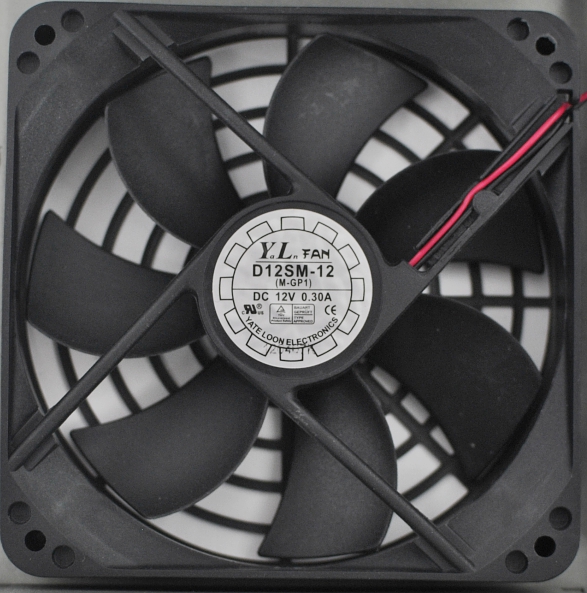
FSP uses a 120mm fan from Yate Loon with a sleeve bearing. The product number is D14SM-12 and it takes 0.30A. A FDB fan would be better but the price could be a problem and Protechnic is still a reason to buy the more expensive Aurum series. FSP differentiates between the two lines by modifications such as this, which helps them reach lower cost markets.
| Cables and Connectors | ||
|
Connector type (length) |
Main | 1x 24-pin (50cm) fixed |
| ATX12V/EPS12V | 1x 4+4-pin (60cm) fixed | |
| PCIe |
1x 6/8-pin (50cm) fixed 1x 6/8-pin (50cm) fixed |
|
| Peripheral | 4x SATA (ca. 55, 60, 65, 70cm) fixed | |
| 1x SATA, 3x HDD, 1x FDD (ca. 55, 70, 85, 100, 115cm) fixed | ||
The internal design looks like a cheaper version of the Aurum series. This time FSP used a Taiwanese manufacturer for all those caps inside. In addition the PCB material is different. However, this is still the active-clamp forward converter we already know, with all advantages and disadvantages given by the design. EMI filtering consists of three chokes, two X-caps and four Y-caps. Both heatsinks are very thin as the components won't heat up too much.
FSP Raider 450W 80Plus Bronze Measurements
Voltage Regulation
| +3.3V Regulation/Ripple and Noise | |
| Load | Voltage |
| 5% | 3.28V (7mV) |
| 10% | 3.27V (9mV) |
| 20% | 3.26V (12mV) |
| 50% | 3.22V (14mV) |
| 80% | 3.19V (15mV) |
| 100% | 3.18V (14mV) |
| 110% | 3.17V (19mV) |
| Crossload +12V max. | +0.91% |
| Crossload +3.3V/+5V max. | -2.42% |
| +5V Regulation/Ripple and Noise | |
| Load | Voltage |
| 5% | 5.03V (6mV) |
| 10% | 5.07V (8mV) |
| 20% | 5.07V (16mV) |
| 50% | 5.05V (18mV) |
| 80% | 4.99V (17mV) |
| 100% | 4.97V (20mV) |
| 110% | 4.95V (22mV) |
| Crossload +12V max. | +3.20% |
| Crossload +3.3V/+5V max. | -4.80% |
| +12V Regulation (Worst Ouput)/Ripple and Noise (Worst Output) | |
| Load | Voltage |
| 5% | 12.01V (3mV) |
| 10% | 11.97V (6mV) |
| 20% | 11.93V (13mV) |
| 50% | 11.87V (28mV) |
| 80% | 11.91V (30mV) |
| 100% | 11.92V (33mV) |
| 110% | 11.91V (32mV) |
| Crossload +12V max. | -4.25% |
| Crossload +3.3V/+5V max. | +3.25% |
Noise Levels
| Sound Pressure Level (Ambient: 16dBA, 1m distance) and Temperatures (Δϑ to 23.2 °C ambient temperature) | |
| Load | Opinion |
| 5% | 19 dBA (1.5°C) |
| 10% | 19 dBA (2.5°C) |
| 20% | 19 dBA (4.8°C) |
| 50% | 24 dBA (5.2°C) |
| 80% | 26 dBA (7.9°C) |
| 100% | 28 dBA (8.8°C) |
| 110% | 28 dBA (9.2°C) |
Efficiency and PFC
| Efficiency and Power Factor 115 VAC | ||
| Load | Efficiency | PFC |
| 5% | 78.15% | 0.852 |
| 10% | 84.46% | 0.918 |
| 20% | 87.62% | 0.938 |
| 50% | 88.67% | 0.956 |
| 80% | 87.73% | 0.971 |
| 100% | 87.19% | 0.983 |
| 110% | 86.84% | 0.988 |
| Efficiency and Power Factor 230 VAC | ||
| Load | Efficiency | PFC |
| 5% | 79.49% | 0.827 |
| 10% | 85.36% | 0.881 |
| 20% | 89.07% | 0.928 |
| 50% | 90.54% | 0.941 |
| 80% | 88.93% | 0.967 |
| 100% | 88.21% | 0.979 |
| 110% | 87.57% | 0.984 |
We can hardly imagine that this is just a Bronze unit, but who cares as long as the price is low (MSRP is $55, tax excluded). FSP told us, "It's an authentic 80 Plus Bronze product, [...] but as you mentioned; its efficiency is close to the AURUM". 12V stays above 11.90V at 110% load.+3.3V starts very low and reaches 3.18V at full load. All of the rails have no remarkable transients and ripple is always below 50% of the allowed level. At high loads, FSP is a little louder than most other PSUs in this roundup, but they are very similar overall.
Enermax NAXN ENP450AWT-B 450W
Enermax is no longer the manufacturer of some of their series (including the NAXN) but they still design their own PSUs or modify well known PCB designs. This time CWT is responsible for the electronics. Besides the common 10A power cable, you get four screws and a user manual. The product features include 80 Plus Bronze certification, the silent fan, and the HeatGuard. The NAXN has two +12V outputs, each of which can be loaded with 17A according to the manufacturer. +3.3 V and +5V are rated at 25A and 20A. In total +3.3V and +5V deliver 120W.

Enermax uses a DC fan from Yate Loon (oh no, not again!) with the model number D12SH-12--a sleeve bearing type. The fan needs 0.30A from the +12V output, and the fan blades pictured above are all transparent.
| Cables and Connectors | ||
|
Connector type (length) |
Main | 1x 24-pin (50cm) fixed |
| ATX12V/EPS12V | 1x 4+4-pin (60cm) fixed | |
| PCIe | 1x 6-pin (50cm) fixed | |
| Peripheral |
2x SATA, 1x HDD (ca. 45, 60, 75cm) fixed 3x SATA, 1x HDD (ca. 45, 60, 75, 90cm) fixed |
|
| 2x HDD, 1x FDD (ca. 45, 60, 75cm) fixed | ||
Once we open the NAXN 450W we are looking at an older CWT power supply that uses a double forward topology. Even with a smaller 450W rating, the PCB is full of components. This is good sign since larger components are equivalent to more power but cooling might be a problem. However, all caps are made by Samxon, pretty low-end. Apart from that we like the extensive EMI filtering and quality.
Enermax NAXN ENP450AWT-B 450W Measurements
Voltage Regulation
| +3.3V Regulation/Ripple and Noise | |
| Load | Voltage |
| 5% | 3.32V (12mV) |
| 10% | 3.32V (14mV) |
| 20% | 3.31V (16mV) |
| 50% | 3.30V (18mV) |
| 80% | 3.29V (22mV) |
| 100% | 3.29V (24mV) |
| 110% | 3.28V (25mV) |
| Crossload +12V max. | +0.91% |
| Crossload +3.3V/+5V max. | -1.82% |
| +5V Regulation/Ripple and Noise | |
| Load | Voltage |
| 5% | 5.03V (7mV) |
| 10% | 5.07V (9mV) |
| 20% | 5.07V (11mV) |
| 50% | 5.05V (13mV) |
| 80% | 4.99V (14mV) |
| 100% | 4.97V (16mV) |
| 110% | 4.95V (16mV) |
| Crossload +12V max. | +2.40% |
| Crossload +3.3V/+5V max. | -2.80% |
| +12V Regulation (Worst Ouput)/Ripple and Noise (Worst Output) | |
| Load | Voltage |
| 5% | 12.01V (4mV) |
| 10% | 11.97V (7mV) |
| 20% | 11.93V (10mV) |
| 50% | 11.87V (13mV) |
| 80% | 11.91V (15mV) |
| 100% | 11.92V (19mV) |
| 110% | 11.91V (21mV) |
| Crossload +12V max. | -3.50% |
| Crossload +3.3V/+5V max. | +3.50% |
Noise Levels
| Sound Pressure Level (Ambient: 16dBA, 1m distance) and Temperatures (Δϑ to 24.6 °C ambient temperature) | |
| Load | Opinion |
| 5% | 19 dBA (0.7°C) |
| 10% | 20 dBA (1.3°C) |
| 20% | 20 dBA (1.6°C) |
| 50% | 22 dBA (5.0°C) |
| 80% | 27 dBA (7.9°C) |
| 100% | 27 dBA (8.8°C) |
| 110% | 27 dBA (9.2°C) |
Efficiency and PFC
| Efficiency and Power Factor 115 VAC | ||
| Load | Efficiency | PFC |
| 5% | 69.23% | 0.824 |
| 10% | 77.68% | 0.906 |
| 20% | 83.14% | 0.935 |
| 50% | 85.92% | 0.963 |
| 80% | 85.17% | 0.977 |
| 100% | 84.88% | 0.981 |
| 110% | 84.32% | 0.985 |
| Efficiency and Power Factor 230 VAC | ||
| Load | Efficiency | PFC |
| 5% | 70.63% | 0.784 |
| 10% | 78.26% | 0.850 |
| 20% | 84.35% | 0.925 |
| 50% | 86.39% | 0.946 |
| 80% | 85.87% | 0.974 |
| 100% | 85.26% | 0.979 |
| 110% | 84.71% | 0.984 |
The bad news is that the fan was audible all the time, but noise was still passable. The different rails start above ideal and end below ideal. The 3.3V rail looks the best, showing the lowest drop. 19 to 27 dBA is an average result among the PSUs we've tested, but we have predominantly looked at quality units so even "average" is good. The NAXN reaches its peak efficiency of 86% at 50% load--a good result.
Comparison: ATX and CPU Cable Lengths
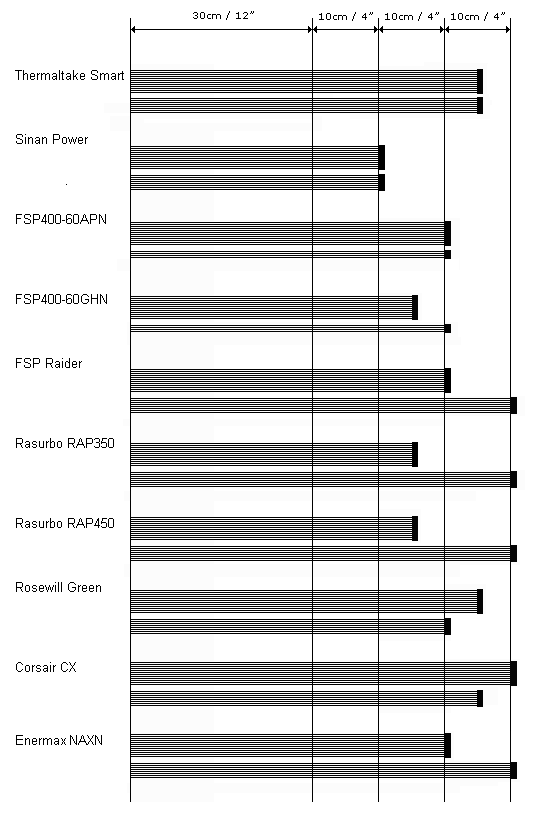
On the following pages we compare the cable lengths to facilitate the buying decision. When using a full-size tower we can hardly recommend the power supply Sinan Power offers. Both OEM products by FSP have just one 4-pin connector for CPUs, but we should keep in mind that FSP modifies the connectors for OEM/ODM customers. be quiet! arrived too late so we finished the picture without their cable configuration.
Comparison: PCI-E Cable Lengths
Comparison: Peripheral Cable Lengths
Conclusion
Some PSUs have no right to exist. The Sinan Power VP-430 430W at €22.40 (about $28) belongs in this classification if you want a reliable PSU. The Sinan Power is a ~215 watts power supply without active power factor correction—not to mention the fact that the efficiency is always below 75%. Sinan Power offers nothing more than three SATA and a few HDD connectors on very short cables. Once again it can be stated that you get what you pay for!
The be quiet! System Power 350W at €29.75 (about $37) is one of the 350W units we can recommend for Office use. The downside of the PSU is that there is no connector for graphics cards, but this shouldn't hurt too much. Three SATA and HDD connectors are provided and there is a floppy connector at 75cm. be quiet! uses Taiwanese capacitors like most manufacturers in this roundup. be quiet! will be finally entering the US market later this year which is a good news for enthusiasts as they deliver the quietest PSUs in Germany.
Thermaltake offers a few power supplies which come up to expectations but the Thermaltake Smart AP-430P 430W at $61.99 didn't do well as the efficiency was low. 83.64% is the highest value we measured during the test. During 20% load Thermaltake didn't even surpass the minimum requirement for 80 Plus. You get the usual set of accessories and cables, but there are no unique features or remarkable results, which should be mentioned.
The Rosewill Green Series RG430-S12 430W at $44.99 provides many connectors except the PCI-E plugs. The model reached up to 84% efficiency and more than 40mV ripple and noise on the smaller rails. This should be avoided next time. However, the PSU stays stable all the time and comes with several extras such as cable ties. In summary, the RG430-S12 is a decent mainstream PSU.
The OEM models by FSP (FSP400-60APN 230V version and FSP400-60GHN(85)) performed well in our test. All the modern FSP PSUs we've reviewed have no problems with ripple and noise, and that trend continues here. However, both models provide just a 4-pin CPU connector and 6 to 9 peripheral plugs. Additionally, you get only one 6-pin connector for graphics cards. Like most PSUs in this roundup both models have all important safety functions including OCP and a common forward converter. All in all we have to criticize the cable configuration, which plays an important part when building a PC.
| Comparison: Max. Efficiency | |
| PSU | Efficiency (230VAC) |
| FSP Raider | 90.54% |
| FSP400-60GHN(85) | 86.76% |
| Enermax NAXN | 86.39% |
| Rasurbo RAP | 86.27% |
| be quiet! System Power | 85.86% |
| Corsair CX430 V2 | 84.90% |
| FSP400-60APN | 84.64% |
| Rosewill Green Series | 83.73% |
| Thermaltake Smart | 83.64% |
| Sinan Power VP-430 | 74.13% |
The Corsair CX430 V2 430W at $39.99 is an affordable power supply with low ripple on all rails. The number of connectors and their distribution is satisfying as well. During the load test the regulation of the output voltage is sufficient, and the efficiency is decent for an 80Plus model. The contents of the package are also very welcome. The power supply uses a well known layout from CWT and it's a cheaper design. The relatively low-end capacitors are acceptable for a PSU in this range. Under load the power supply is clearly audible, reaching up to 27 dBA.

The Rasurbo RAP350 350W at €30.84 (about $39) and RAP450 450W at €43.59 (about $55) use Taiwanese capacitors from Teapo, there's a lot of space for cooling and airflow, and they've chosen better MOSFETs than Thermaltake. The RPMs are tolerable up to 50% load causing a low fan noise. In terms of voltage stability, the 3.3V rail measures 3.19V during our overload scenario. All the other outputs are closer to their optimal values. The package includes all important extras and 86% efficiency is pretty nice. In addition there are two PCI-E connectors at the 450W model. We are pleased to present Rasurbo with our Bronze Editors' Choice award.

The Enermax NAXN ENP450AWT-B 450W (no price available) is very efficient and stable. In addition Enermax provides one more SATA connector and longer cables than Rosewill which is usually more important than a few additional HDD plugs. There is no heavy increase in acoustic noise during operation, but the fan already starts at a high RPM. Beside this we couldn't find any major flaws. Inside we found the same double forward topology Corsair used. However, Enermax has more efficient components and the cable configuration is more extensive. In addition the NAXN used a better looking cable sleeving, probably the best in this roundup. Enermax also performed well, reaching low ripple and noise results and an ideal voltage regulation. Last but not least we can recommend the PSU because of features like the HeatGuard and many safety functions. Enermax deservedly earns our Silver Editors' Choice Award for providing a (nearly) flawless product.
The FSP Raider 80Plus Bronze 450W at a MSRP of $55 is the most expensive PSU in this roundup for the simple reason that they offer the best product. FSP provides two PEG connectors instead of one (which is enough to run either a lower-end SLI/CF setup or a single high-end graphics card with two PEG jacks), a 5-year warranty and a very high efficiency. In fact the efficiency was ~4 percentage points above the second best result (230VAC) and way above the necessary values for 80Plus Bronze (Silver at 115VAC, Gold at 230VAC). FSP integrated well chosen components and the well known active-clamp design. Moreover FSP implemented all safety functions including OCP. Five SATA connectors and a very long CPU cable perfect the PSU. The fan's RPM and the load rise equally, but the noise is still acceptable compared to the Aurum models. We’re awarding FSP our Gold Editors’ Choice award.

